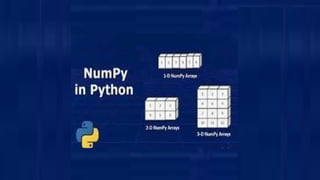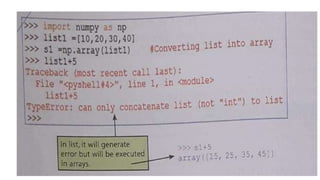arraycreation.pptx
- 2. Array creation 1• To create a one-dimensional NumPy array, we can simply pass a Python list to the array() method Example 3 ( ) ( )
- 3. • We can easily make out the difference between a list and an array representation in Python. In list, elements are separated by a comma, whereas an array is like a collection of elements without a comma separator in between. import numpy as np lst = [1,2, 3,4] a=np.array (lst) print(lst) print (a) a [1, 2, 3, 4] [1 2 3 4] array([1, 2, 3, 4])
- 4. 2 fromstring() We can also create one-dimensional array from String. [1 2 10 12]
- 5. Creation of 2D NumPy Array • multiple lists can be used to create 2D arrays. To create a two-dimensional array, you can pass a list of lists to the array method as shown below:
- 6. Dimension NumPy Arrays provides the ndim attribute that returns an integer that tells us how many dimensions the array have import numpy as np a = np.array(42) b = np.array([1,2,3,4,5]) c = np.array([[1,2,3], [4,5,6]]) print("Dimension of array a is:", a.ndim) print("Dimension of array b is:",b.ndim) print("Dimension of array c is:",c.ndim)
- 7. Access Array Elements • Array element can be accessed by referring to its index number. • The indexes in NumPy arrays start with 0, meaning that the first element has index 0, and the second has index 1 etc. Get third and fourth elements from the array and add them. import numpy as np arr = np.array([1,2,3,4]) print("The first element is :", arr[0]) print("The 2nd element is :",arr[1]) print("Sum of 3rd and 4th elements are :",arr[2] + arr[3])
- 8. • To access elements from 2-D arrays we can use comma separated integers representing the dimension and the index of the element. import numpy as np arr = np.array([[1,2,3,4,5], [6,7,8,9,10]]) print('2nd element on 1st dim: ', arr[0, 1])#Access the 2nd element on 1st dim: print('5th element on 2nd dim: ', arr[1, 4])#Access the 5th element on 2nd dim: print('Last element from 2nd dim: ', arr[1, -1])#Use negative indexing to access an array from the end. Ouput: 10 Example arrayname [ rownum, columnnum ]
- 9. Output: NumPy arrays have an attribute called shape that returns a tuple with each index having the number of corresponding elements. import numpy as np arr = np.array([[1, 2, 3, 4], [5, 6, 7, 8]]) print(arr.shape) Output: (2, 4), which means that the array has 2 dimensions, and each dimension has 4 elements.
- 10. Difference between NumPy Array and Python Lists • NumPy is an alternative for lists in Python as it holds less memory, has faster processing, and is more convenient to use. • • The difference between the elements is that the NumPy array has to be homogenous. (All elements should be of the same type) • Arrays in NumPy are more compact when we compare it to lists. • NumPy arrays are stored at one continuous place in memory • NumPy array supports vectorised operation, i.e., you need to pertorm any function on every /element of a sequence one by one which is not supported in Python lists.
- 11. Summary


![• We can easily make out the difference between a list and an array
representation in Python. In list, elements are separated by a comma,
whereas an array is like a collection of elements without a comma
separator in between.
import numpy as np
lst = [1,2, 3,4]
a=np.array (lst)
print(lst)
print (a)
a
[1, 2, 3, 4]
[1 2 3 4]
array([1, 2, 3, 4])](https://image.slidesharecdn.com/arraycreation-220822161726-b5da5cb8/85/arraycreation-pptx-3-320.jpg)
![2
fromstring() We can also create one-dimensional array from String.
[1 2 10 12]](https://image.slidesharecdn.com/arraycreation-220822161726-b5da5cb8/85/arraycreation-pptx-4-320.jpg)

![Dimension
NumPy Arrays provides the ndim attribute that returns an integer that
tells us how many dimensions the array have
import numpy as np
a = np.array(42)
b = np.array([1,2,3,4,5])
c = np.array([[1,2,3], [4,5,6]])
print("Dimension of array a is:", a.ndim)
print("Dimension of array b is:",b.ndim)
print("Dimension of array c is:",c.ndim)](https://image.slidesharecdn.com/arraycreation-220822161726-b5da5cb8/85/arraycreation-pptx-6-320.jpg)
![Access Array Elements
• Array element can be accessed by referring to its index
number.
• The indexes in NumPy arrays start with 0, meaning that the
first element has index 0, and the second has index 1 etc.
Get third and fourth
elements from the array and
add them.
import numpy as np
arr = np.array([1,2,3,4])
print("The first element is :", arr[0])
print("The 2nd element is :",arr[1])
print("Sum of 3rd and 4th elements are :",arr[2] + arr[3])](https://image.slidesharecdn.com/arraycreation-220822161726-b5da5cb8/85/arraycreation-pptx-7-320.jpg)
![• To access elements from 2-D arrays we can use comma
separated integers representing the dimension and the
index of the element.
import numpy as np
arr = np.array([[1,2,3,4,5], [6,7,8,9,10]])
print('2nd element on 1st dim: ', arr[0, 1])#Access the 2nd element on 1st dim:
print('5th element on 2nd dim: ', arr[1, 4])#Access the 5th element on 2nd dim:
print('Last element from 2nd dim: ', arr[1, -1])#Use negative indexing to access an array from the end.
Ouput: 10
Example
arrayname [ rownum, columnnum ]](https://image.slidesharecdn.com/arraycreation-220822161726-b5da5cb8/85/arraycreation-pptx-8-320.jpg)
![Output: NumPy arrays have an attribute called shape that returns a tuple with each
index having the number of corresponding elements.
import numpy as np
arr = np.array([[1, 2, 3, 4], [5, 6, 7, 8]])
print(arr.shape)
Output: (2, 4), which means that the array has 2 dimensions,
and each dimension has 4 elements.](https://image.slidesharecdn.com/arraycreation-220822161726-b5da5cb8/85/arraycreation-pptx-9-320.jpg)



